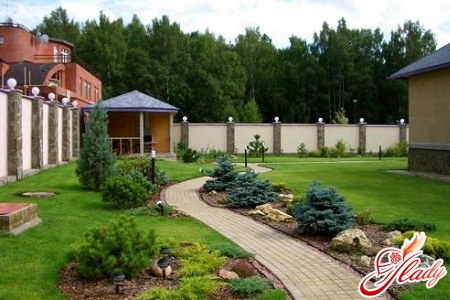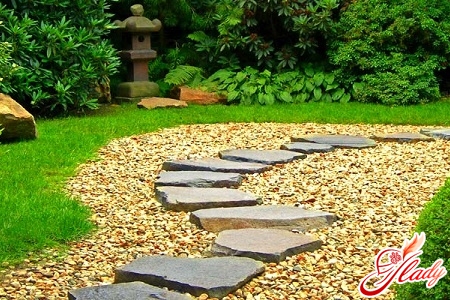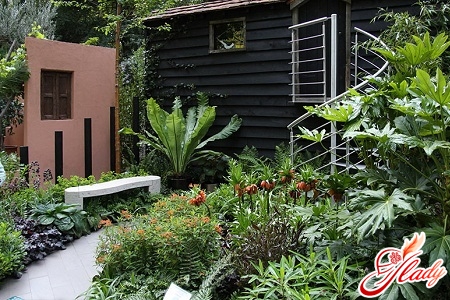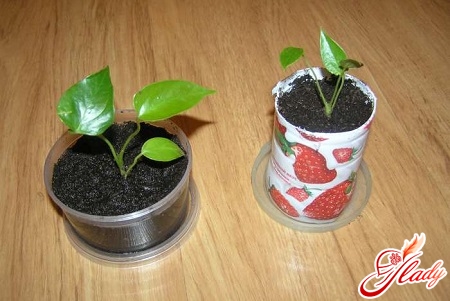 The passion for landscape design is very popular todaypopular among gardeners. Flower beds, alpine slides and lawns are increasingly replacing vegetable beds. Reservoirs and fountains are arranged on the plots, decorative wells and gazebos are built. And, of course, paths and trails are laid out among all this man-made splendor. Paths in the garden are needed, first of all, for ease of movement. But they can also decorate it, add an additional note to the aesthetic symphony of the garden. You can hire craftsmen to build them, or you can make paths in the garden with your own hands. Paths can be made of wood or stone, brick or concrete. The technologies for laying them are largely similar, and almost any owner of a plot can easily lay garden paths with his own hands. It is only important to plan them correctly, choose the right material and get down to business.
The passion for landscape design is very popular todaypopular among gardeners. Flower beds, alpine slides and lawns are increasingly replacing vegetable beds. Reservoirs and fountains are arranged on the plots, decorative wells and gazebos are built. And, of course, paths and trails are laid out among all this man-made splendor. Paths in the garden are needed, first of all, for ease of movement. But they can also decorate it, add an additional note to the aesthetic symphony of the garden. You can hire craftsmen to build them, or you can make paths in the garden with your own hands. Paths can be made of wood or stone, brick or concrete. The technologies for laying them are largely similar, and almost any owner of a plot can easily lay garden paths with his own hands. It is only important to plan them correctly, choose the right material and get down to business.
We plan the garden paths
In order for the paths to fit harmoniously intothe general style and architecture of garden plots, they must be properly planned. Both visually and functionally, the garden is divided into several zones. The main task of paths and trails is to facilitate the path to garden buildings, beds and flower beds. Depending on their purpose, paths should have different widths, lengths and shapes. How to calculate the width of a garden path? The main "highways" lead from the gate to the house and from the house to other frequently visited buildings (kitchen, gazebo, toilet, shed, pool). Their width should be from one to one and a half meters. Paths that you have to walk less often can be made narrower - half a meter, a meter. And very narrow (no more than half a meter) - paths between the beds. When calculating the length, you do not have to be too clever. It will be determined by the distance of the destination (unless you are a supporter of roundabout routes). But with the shape, things are a little different. If you adhere to a certain style when arranging your garden, then the shape of the path in the garden should be decided in the same style. For example, straight paths are appropriate for a classic English or Japanese garden. If the style of your garden can be called landscape or rustic, then winding and twisting paths will look organic in it. But most often, garden paths are laid along an already trodden path. And its geometry is determined by the obstacles it encounters (or lack thereof). Therefore, it is better not to change the shape of the path in this case - you will still walk the way you are used to. So, your plans are in order, and now comes the most difficult choice.
We choose the construction
The track surface determines its design.Paths can be monolithic, bulk and paved. Here everything depends on your preferences, means and physical capabilities. Monolithic paths are made of cement, concrete and asphalt. They are durable, strong and reliable. But! If you are making paths in the garden yourself, then think carefully before choosing this method. It requires certain construction knowledge and skills. Therefore (in order to avoid a disastrous result) do not experiment. A more suitable method for independent construction of garden "highways" is bulk. Paths can simply be covered with sand, wood mulch, gravel, pebbles or crushed stone. Of course, this method also implies the use of building codes. But it is quite feasible even without the involvement of specialists. And finally, the most common method today is paving. This is where your imagination and artistic ideas can run wild! You can pave a path with natural (or artificial) stone, wood, paving slabs, and brick. So what should you choose in the end?
Choose the materials
Natural materials – stone, wood, graveland sand. Sand is the most accessible material. Paths made from it are beautiful and neat, but not for long. At least once a year, such paths have to be renewed. Stone is considered the best material for garden paths. Expensive aristocratic stone is granite, basalt, marble and porphyry. Paths made from it look rich and solid. But at the same time, they have a significant drawback - they become very slippery in winter. Electric heating systems must be installed under paths made of such stone. Simpler stones have a lower degree of slip (as well as price). These are sandstone and limestone. Natural stone is sold in the form of flagstone and cobblestone. It differs from other materials in a wide variety of textures and a rich palette of colors. But, unfortunately, due to the high price, it is not available to everyone. More affordable prices are for gravel, crushed stone and pebbles. For paths made of these materials, you should choose smaller stones, and reinforce the sides. They (unlike the same sand) do not require frequent renewal, but are not very pleasant for bare feet. Wood is a special material, "alive and warm". It is used in the form of log cuts, boards, sawdust and mulch. Sawdust and mulch are poured in layers and rammed. The cuts are dug into the ground, and the boards are laid on bars (logs). The main disadvantage of wood is that it gets soggy from moisture. You can buy excellent modern materials made of wood - decking and garden parquet. They are more durable, but also more expensive. Artificial materials - paving slabs, brick, rubble stone. Paving slabs are very diverse in both shape and quality. Like artificial stone, it is easy to use, and therefore very popular in the construction of paths. Brick can be called an ideal material. It does not fade, it is durable and frost-resistant. It is easy to fold geometric patterns from it. As you can see, different types of garden paths are determined not only by the way they are constructed, but also by the materials used for the covering. The quality of garden "highways" largely depends on the covering. The durability of the paths is also affected by technology.
Building Technologies
We will not go into detail about the process of laying paths in your garden - there are textbooks for this. However, we will focus on the points common to any technology.
- Foundation. This is most important for road construction. Under any path a drainage layer is necessary. Drainage will not allow water to accumulate and thereby protect the coating from damage.
- Trench. For any garden path, it is necessary to excavate a trench, into which the foundation will be laid. In addition, the trench for the track must necessarily be treated with herbicides. This will not allow the weeds to conduct their active destructive work and insult your aesthetic taste.
- Borders. They not only improve the appearance of the track, but also protect it from blurring and sprawling to the sides.
These are all general technological requirements.But for each type of paths there is its own, special technology. And for high-quality construction it is necessary to study it. Then you will be able, if not to become a builder, then at least to control the process with knowledge of the matter.
Decorative design
And finally, I would like to remind you about the decorativecomponent of garden paths. Flowers will turn any path into a fairy-tale path in your garden. Plant border multi-colored annuals, unpretentious variegated hosts or a hedge along the paths. And to make the garden even more beautiful, organize lighting. To do this, you can place solar-powered garden lights along the sides of the paths. Such lighting will create a fairy-tale effect, making the garden path almost a magical path. When choosing a covering for a path, think about how it can be used for decorative purposes: lay it out in the form of an ornament or mosaic, combine it with grass, add severity and geometry. In any case, decorated paths in your garden will not just be pedestrian crossings, but a harmonious element of the garden, fairy-tale paths. Remember which road Ellie took to get to the Emerald City? Along the yellow brick road. But someone built it too... We recommend reading:









